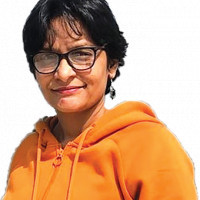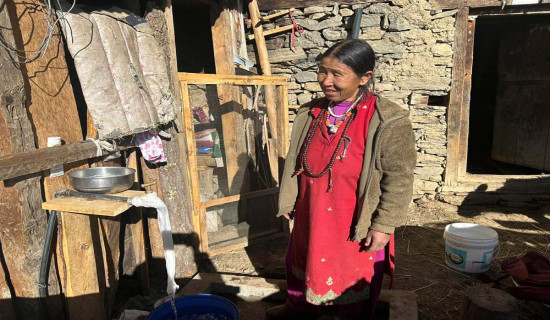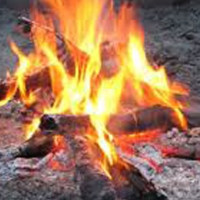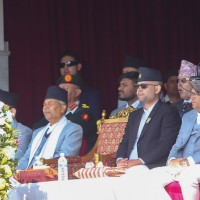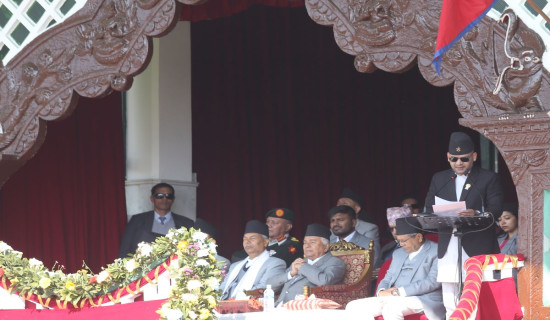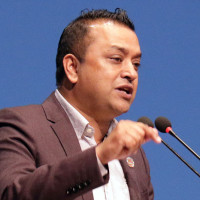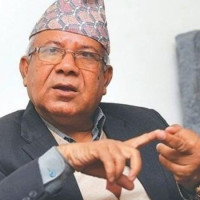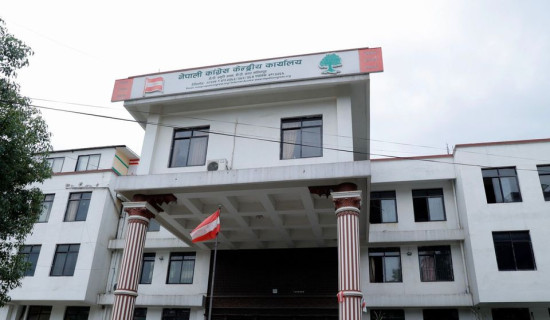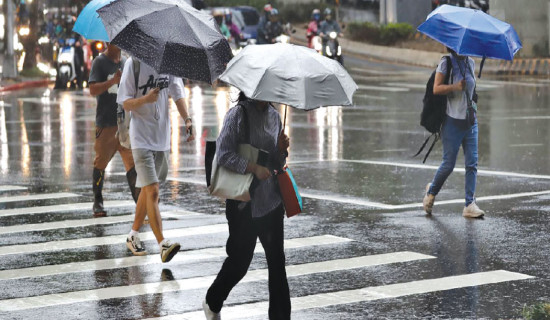- Monday, 15 December 2025
Experts urge action on climate loss and damage
Kathmandu, May 18: On the second day of the Sagarmatha Sambaad, climate experts point out the urgent need for climate financing and global cooperation to address the disproportionate impacts of climate change on the Himalayan region.
Speaking at the parallel session on “Addressing Loss and Damage in the Mountains,” speakers stressed the need to implement adaptation programmes to cope with the impacts of climate change.
Delivering the keynote speech, Ibrahima Cheikh Diong, Executive Director of the Fund for Responding to Loss and Damage, said infrastructure needs to be rebuilt, particularly in countries struggling to meet basic needs. “The loss and damage crisis is an additional burden, and many countries are facing this common challenge,” he said.
He stressed the importance of acknowledging the physical and social realities of climate crises, as well as the fund’s role in responding to these challenges. “We face numerous problems caused by the current climate crisis, including devastating impacts on developing countries and vulnerable communities. Many communities have been severely affected, suffering damage to lives, homes and infrastructure. The crisis disproportionately impacts developing countries, especially in Africa, Asia and other vulnerable regions.”
“It is crucial that we continue to engage in conversations about loss and damage, involving affected countries and communities.
Governments and partners must work together to ensure that funding is available and accessible to meet the needs of those impacted. Our fund aims to be responsive, inclusive and country-led, providing support where it is most needed,” he added.
Mukhtar Babayev, Minister of Ecology and Natural Resources of Azerbaijan and President of COP29, said, “We have been discussing loss and damage since the early days of the 1992 Earth Summit in Rio. We adopted various international mechanisms to build capacity and collaboration. At COP27 in Egypt, we agreed on the principle of the fund, at COP28 in Dubai, we adopted the structure of how it would work, and at COP29, we are taking the final steps to get it up and running.”
“Loss and damage funding must be delivered effectively through coordinated efforts involving governments, financial institutions, the private sector, and civil society. We must exchange technical knowledge, share experiences, and identify gaps to improve responses,” Babayev added. High-level dialogue and partnerships are key to maintaining global attention and action on loss and damage, he said.
Rajesh Sharma, Global Programme Specialist at UNDP’s Crisis Bureau in Thailand, said that there are important lessons from the past regarding loss and damage. “This process is ongoing and sensitive to context, with many partners involved. Since last year, efforts have been underway to integrate economic assessments with participation from various partners, including governments focused on adaptation.”
Similarly, Dr. Arun Bhakta Shrestha, Senior Climate and Environmental Risk Advisor at ICIMOD, said the nature of climate hazards are becoming more complex, with multiple hazards occurring simultaneously. “The world has experienced several climate-related disasters recently, many of which are more frequent and severe due to climate change. This complexity requires us to consider multiple perspectives.”
“Attribution of loss and damage is complicated. We need different approaches to assess financial and non-financial losses, accounting for uncertainties and future risks. This is not simple, but we are collaborating with partners and experts to develop better methods,” Dr. Shrestha said.
Maureen Santos, Coordinator of the Socio-Environmental Justice Programme at the Heinrich Böll Foundation in Brazil, emphasized that climate justice requires clear definitions and strong institutional frameworks. “It is not just about financial compensation but also empowering communities to have a voice in decision-making.”
She stressed that the participation of affected communities is essential. “Reparations should acknowledge historical responsibilities and ensure equitable distribution of resources. Many communities have been disproportionately affected by climate change, and this fund must address those inequalities.”
Dr. Anil Kumar Gupta from India’s Department of Science and Technology said, “When we talk about loss and damage, we must clearly define what damage means. There are physical damages and less visible losses, such as those related to culture, health and social systems.”
“We must recognise the limits of adaptation, there are risks that cannot be fully mitigated. Business and community impacts are significant and often interconnected. For example, in India, infrastructure damage accounts for over 90 per cent of climate-related losses. The government has recently created new funding to address these challenges, but a large gap remains between needs and available resources,” he said.
He also said that research, policy and practice must be better linked. “Data systems and scientific evidence are essential for improving loss and damage responses. India is committed to supporting research and policy integration to better address these issues.”
Other sessions during the day included Powering the Future: Harnessing Clean Energy; Exploring Nature, Culture, and Adventure in the Mountains; Mountain Risk Assessment and Monitoring; Sustainable Cities and Communities; Building an Inclusive Future: Gender and Intergenerational Equity; Bridging Science and Technology for Mountain Resilience; Sustaining the Mountain Economy; Collaboration and Cooperation Beyond Borders: HKH Ministerial Meeting; Unlocking Youth Potential in Science, Technology, and Innovation; and a multi-stakeholder roundtable.


